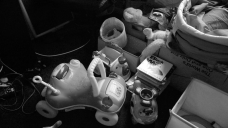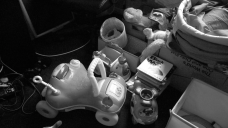
-
I have shot with colored filters on many different cameras before. The concept is nothing new but rarely used with digital, we used 85 filters with film every day - but those and the related 80 filters were used to get CORRECT color balance (including the referenced use on the original tungsten impaired Red One sensor), not to throw color balance completely off.
I noticed no improvements of the sorts mentioned here on digital, only later difficulty color correcting back to normal when shooting with wacked balance - that's why I've asked to see examples from those who have said they've seen improvements. I'd love to learn about a useful technique, but I must be looking in the wrong place for the difference - I'll need it pointed out.
I don't "guess" about cameras, btw, I know from experience.
The thread in question was shut down because of Aki not backing up his claims when asked (by many including moderators) and then threatening to sue members over it.
-
I tell you what...I invite those of you arguing to go out and test it for yourselves to prove or disprove this theory. @nothing...don't bring the arguments over here please. It's really because of you that the thread was shut down. If the guy will not budge on what YOU want then maybe it's just time for YOU to go out and prove he's wrong. Don't turn this into another he-said-she-said kind of argument. If you just don't want to try it yourself and chose not to believe his argument...then just walk away. Honestly Aki isn't bringing up anything that I have not heard of before and I understand what dikitsov is trying to say earlier...but...prove it right...prove it wrong or...just stop guessing/arguing.
@Aki...my suggestion to you is this: There have been many requests from folks here asking for you to do a before (Raw/AVCHD file from camera) and after with video. Before responding to any other threads about the benefits of this or that....just produce what the readers want to see. I understand you want to demonstrate your workflow.....but let that be last on the priority list. I think some just don't care about workflow until they see "actual" results from a before and after video. It's at that point where a workflow will make sense (or not) for everybody.
EDIT: @nothing and @zcream FYI...it's not that I don't agree with you btw.
-
Looks like there is still room for improvement even for GH13.
The hack settings that I hastily created (25p iW) as a last ditch attempt to cure the false contrast and aliasing in Native settings are the most organic and cinematic I have received from this camera thus far. I am going to look into the compression as soon as I get a production filmed with the current settings. If the compression could be improved slightly, I don't think I will be needing a GH2 anytime soon.
Also, the planned comparison of the colors to actual film stocks will begin as soon as possible.
-
http://provideocoalition.com/index.php/aadams/story/cameras_now_its_rocket_science/
VK posted a snip-it of this on another topic and the most interesting thing was the poster saying that on The Red camera he used blue filters to improve the image. He also goes into different cameras strengths and weaknesses and that you have to shoot with them in mind.
I'm not sure anymore about how much a filter can improve FPN, if you got it bad, it's bad, but outdoors in daylight, I'd defenitely use a color filter. Changed topic title to reflect current topic thinking.
-
So the choices are :- Correct WB for daylight and well lit scenes. For low light=
use 5000K WB
Alternatively use a 85b or magenta filter and accept 2/3 stop light reduction.
WB set at correct color temp (or 3200K) pushed about some clicks to blue and some down towards magenta.
Is this a reasonable summary ?
-
Very low sensitivity of red channel compared to green channel (white balance on 1.6 stops)
-
What does this mean ?
Очень низкая чувствительность красного канала относительно зеленого (баланс белого на 1.6 стопа)
-
You can try to read this small thing (use google translation)
http://blog.lexa.ru/2011/12/02/o_sinem_tsvete_i_zelenykh_kanalakh_panasonic_g3.html -
@aki_hartikainen From what I gather, your recent color filter tests were all done on the GH1. In my experience, that camera has a greenish cast, compared to the GH2. When shooting footage on the GH1, I correct for this by setting the GH1's WB+ adjustment to M-5 (after setting the white balance for the scene). That seems to do the trick:
In the video above, the first clip is from the GH1, the second from the GH2, and the third from the Nikon D5100. Color correction was done on the GH1 in-camera.
On both GH1 and GH2, there's an easy way to check out the individual R, G, and B histograms before you shoot. Make sure the camera is set to sRGB mode, and that Manual still photo mode is set the same as Creative Movie Mode (in Manual exposure mode of course). Then frame and expose your shot in Creative Movie Mode, and switch to Manual photo mode to snap a still frame. (This insures that your still photo settings match your video settings.)
In Playback mode, you can then display the individual R, G, B, and Y histograms next to the photo and compare their levels. When I do this with a broad-spectrum scene using my M-5 setting, all three color channels turn out reasonably well-balanced, and require no further color correction.
-
Hi, I'm that guy with some years of experience in tv and film industry, and have also studied the subject of photochemistry in university for a few years. The benefits of using a color filter have become obvious. It is a combination of several factors. It's true that the Green channel gets compressed, but it is already of very good quality so the benefits outweigh the negative aspects.
In the 2008 tests they found improvment from using a magenta filter even for 4:4:4 material. The few comments above completely ignore the fact that for video the data is turned into YUV format and a lot of color information gets simply discarded and tossed away. Any extra color bits will help encode the color channels better. This is achieved using a color filter. If all channels are recorded on the same relative levels (no color filter), this is a license for the video encoder to discard color bits. Using a color filter over-saturates the color so the video encoder is no longer licensed to discard as much color as before. This will help in post while grading. There is no other way to achieve the same results other than coloring the lights.
No technique will repair the colors in post that have been compressed too heavily. It is true that it will be difficult to WB the colors to baseline, but do you always want that? All the extra color can be used to grade the material to one's liking with better quality than before. And the improvment in color rendition is substantial. I have a small demo video filmed in rather extreme lighting conditions.
In this case it was possible to change the colors for the primary palette (light with outdoor color temperature) and the secondary palette (light from LED lamps). There is no substantial light loss because of less noisy and higher quality material. Anybody has to evaluate whether the colors achieved this way can be used for certain purposes, but they will be better quality and grade more easily.
-
All the theory talk means nothing if the final results prove to be an improvement! Theoretically Bumble Bees shouldn't be able to fly... If the guy is finding visual improvements using his filters, then perhaps there's something happening that the sensor theory isn't taking into account.
-
@dkitsov ...you said"BS. Lets improve image by letting less light to the sensor."
So...you were the one who started talking about "light" not color. Sorry if my comment out sarcasm'd yours. ^_^
-
@CRFilms @dkitsov ...yes never shoot with ND filters outdoors, just use shutter and apature to get the best image. >_> Logical fallacy. ND filter ideally should not change the color balance neither should the aperture/shutter speed combination. This discussion is about changing the color of the light that reaches the sensor sights, not about the means of overall exposure control. Sensor needs as much light as it needs. Ways of limiting it with ND or shutter/aperture, while makes aesthetic, difference probably makes no "electrical" difference as far as ISO adjustment is not involved (that would move the sensor from the optimum operating range)
-
Wow, I don't even know where to begin... Yet again you are working with a sensor that has a limited dynamic range. The only way any color filtration filtration would be useful is to measure what is the color temp of the light that would provide the widest dynamic range for each of the groups of the sensors behind its respective colored filters and then walk around with the set of the filters (just like in the film days) and use them accordingly after measuring the spectrum of the scene light with a spectrometer, in effect linearizing the sensor to its optimum behavior. Now let's assume for a moment that the people at sensor design lab at Panasonic are not complete idiots, let's assume for a moment that the color science guys are also not complete idiots at Panasonic and the sensor is actually build and tuned to run well at lets say 6500K (most likely). That assumption makes it so that white points of green, red and blue sensors are roughly at the level when exposed at that light with an appropriate (Daylight) setting. Then, by applying the purple filter you are lowering the dynamic range, artificially clamping green channel by underexposing it. Then you have to stretch it later later in post, lowering the number of real shades of grey in the green channel. On an 8 bit image. Creating banding. You guys will always hunt for some pseudo science voodoo, Go out and shoot. I have a fuel magnet to sell to you.
-
It depends completely on the lighting situation. If it's daylight with very high energy in blue – in elevated places at noon it can be much more than 6500 K – you'll blow the blue channel very early with purple (or any filters other than orange).
IMHO, any colored filter only makes sense to decrease the strongest channel to avoid starving the others if there is a massive misbalance. It doesn't really help much with the 4:2:0 vs. 4:2:2 issue.
-
@dkitsov ...yes never shoot with ND filters outdoors, just use shutter and apature to get the best image. >_>
@Aria ...yes, that's the way I understand it. I'm not sure now that this will be much help with FPN at max ISOs, but I defenitely think, at least outdoors, this coupled with a ND filter could give you a better image than just the ND filter.
-
@dkitsov, I thought the idea was that you're allowing the sensor's Blue and Red channel to get more saturation by basically pushing the amount of light in those bands to hit the sensor as opposed to the dominant Green, which will always have more sensitivity than the other channels. So Blue and Red get what they need in order to lower noise in the Blue and Red. I may not be describing it well, but that's how I understood it.
-
BS. Lets improve image by letting less light to the sensor.
-
http://www.libraw.org/articles/magenta-filters-on-digicam.html
"The point in using magenta filter is to achieve better exposure of red and blue channels by allowing less light to hit the sensors under the green filters of sensor CFA. This is physical, pre-capture filtration; and as such it can't be reproduced by tuning the camera or through post-processing."
The guy just found this article from 2008 talking about how a magenta filter can create a better image in your DSLR shooting in daylight. Said there is a sweet spot for WB with a filter that can give less noise, but it's different for each hack and ISO so you'll have to test the settings yourself to figure out what works for you at what ISO, bitrate and WB.
I got my filters and did a quick shoot outside and the purple filter gives the outdoor footage a nice look. File Purple is the image with the filter, PurpCC is the video with some basic color correcting.

 Purple.png1920 x 1080 - 1M
Purple.png1920 x 1080 - 1M
 PurpCC.png1920 x 1080 - 1M
PurpCC.png1920 x 1080 - 1M -
GH1 WB Noise FPN Test ISO 1600, 2500K-10000k
Decided to test each WB setting from 2500k to 10000K at 500k increments to see if some looked noisier or had more FPN. The 2500K looks real FPNy but grade it a bit and denoise it a touch and that really gets rid of most of it. Conversly if you take 10000k and grade it down to more blue it gets a ton of FPN visible. I don't know enough about CC'ing or grading to know if I'm doing something wrong, but definitely some settings show more FPN than others, but you can find that FPN in grading if you do it wrong.
-
I'm very sure that there is no difference between setting your WB to pink/magenta and using a colour filter, (unless you're after some kind of vignetting 8 or 16mm film effect and you've got a graduated filter for the job, yeah, good look CCing that to a baseline). I just did some quick tests. All shots were in the Smooth profile all at -2. In order there is a shot of the scene with normal WB, then one where I set WB to green to get pink. The next shot is the version of the pink WB I corrected (not perfect but in the rough ballpark really), then there are shots of the red channel of both the correct WB and the corrected pink WB shots.
The red channel is different, I'll give it that. There does seem to be much better definition of the edges in the shot, smoother shifts (less chance of banding), and better response in the shadows. (more detail perhaps ?). Correcting the footage does make for deeper, and in this case, more accurate reds. Anyhow, more, proper tests are needed. As you can see it creates quite a big difference with only a subtle pink WB shift (although you do drop a fair bit of the overall light too). I'm not sure if this is giving more detail/better chroma sampling, or if its just causing a colour shift to red after correction, although the evidence in the red channel does indicate something positive is happening.
All shots were made with the @bkmcwd GOLGOP3 patch with the Sedna matrix with a GH2. Oh, another note, the average bitrate did drop from 130Mbps to 115Mbps from the correct WB to the pink WB.
Edit : Added a better correction of the pink WB version.

 smooth_normalWB.png1920 x 1080 - 2M
smooth_normalWB.png1920 x 1080 - 2M
 smooth_pinkWB.png1920 x 1080 - 3M
smooth_pinkWB.png1920 x 1080 - 3M
 smooth_pinkWB_corrected.png1920 x 1080 - 3M
smooth_pinkWB_corrected.png1920 x 1080 - 3M
 smooth_normalWB_redchannel.png1920 x 1080 - 1M
smooth_normalWB_redchannel.png1920 x 1080 - 1M
 smooth_pinkWBcorrected_redchannel.png1920 x 1080 - 3M
smooth_pinkWBcorrected_redchannel.png1920 x 1080 - 3M
 smooth_pinkWB_better.png1920 x 1080 - 3M
smooth_pinkWB_better.png1920 x 1080 - 3M -
On a similar topic, this video of Green state that we should always use in-door WB and fix the footage in post for getting rid of a lot of noise in the green channel:
Howdy, Stranger!
It looks like you're new here. If you want to get involved, click one of these buttons!
Categories
- Topics List23,992
- Blog5,725
- General and News1,354
- Hacks and Patches1,153
- ↳ Top Settings33
- ↳ Beginners256
- ↳ Archives402
- ↳ Hacks News and Development56
- Cameras2,367
- ↳ Panasonic995
- ↳ Canon118
- ↳ Sony156
- ↳ Nikon96
- ↳ Pentax and Samsung70
- ↳ Olympus and Fujifilm101
- ↳ Compacts and Camcorders300
- ↳ Smartphones for video97
- ↳ Pro Video Cameras191
- ↳ BlackMagic and other raw cameras116
- Skill1,960
- ↳ Business and distribution66
- ↳ Preparation, scripts and legal38
- ↳ Art149
- ↳ Import, Convert, Exporting291
- ↳ Editors191
- ↳ Effects and stunts115
- ↳ Color grading197
- ↳ Sound and Music280
- ↳ Lighting96
- ↳ Software and storage tips266
- Gear5,420
- ↳ Filters, Adapters, Matte boxes344
- ↳ Lenses1,582
- ↳ Follow focus and gears93
- ↳ Sound499
- ↳ Lighting gear314
- ↳ Camera movement230
- ↳ Gimbals and copters302
- ↳ Rigs and related stuff273
- ↳ Power solutions83
- ↳ Monitors and viewfinders340
- ↳ Tripods and fluid heads139
- ↳ Storage286
- ↳ Computers and studio gear560
- ↳ VR and 3D248
- Showcase1,859
- Marketplace2,834
- Offtopic1,320









